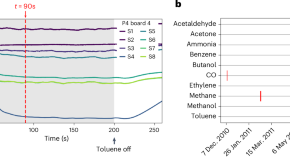Thank you for visiting nature.com. You are using a browser version with limited support for CSS. To obtain the best experience, we recommend you use a more up to date browser (or turn off compatibility mode in Internet Explorer). In the meantime, to ensure continued support, we are displaying the site without styles and JavaScript.
- View all journals

Biological sciences articles from across Nature Portfolio
Biological sciences encompasses all the divisions of natural sciences examining various aspects of vital processes. The concept includes anatomy, physiology, cell biology, biochemistry and biophysics, and covers all organisms from microorganisms, animals to plants.

Understanding the genomic basis to empower sweet potato breeding
Deep genome sequencing and comprehensive phenotyping of 294 samples of hexaploid sweet potato identify genomic loci with an increase in the number of copies of alleles that enhance the expression of 23 agronomic traits during breeding. These findings offer valuable insights to guide trait improvement in sweet potato and other polyploid crops.

Checkpoint blockade regulates T cell fate by supporting co-stimulation
By tracking the fate of tumor-specific T cells mobilized in lymph nodes by dual blockade of PD-1 and TIGIT, we show that both exhausted T cells and effector T cells can emerge from a common progenitor. Signaling by the co-stimulatory receptors CD28 and CD226 is important for deciding between these two cell fates.

Green steel, thunderstorms and next-generation gene editing: a year of remarkable science
Highlights from News & Views published in 2024.
Related Subjects
- Biochemistry
- Biological techniques
- Biotechnology
- Cell biology
- Chemical biology
- Computational biology and bioinformatics
- Developmental biology
- Drug discovery
- Microbiology
- Molecular biology
- Neuroscience
- Plant sciences
- Structural biology
- Systems biology
Latest Research and Reviews

Harnessing the biology of regulatory T cells to treat disease
Regulatory T cells keep the immune system in check to maintain homeostasis and restrain inflammation. This Review discusses strategies to harness these cells therapeutically for autoimmunity, transplant tolerance or cancer, for example, by boosting their endogenous function, depleting them or administering them as engineered cell-based therapies.
- Christine M. Wardell
- Dominic A. Boardman
- Megan K. Levings

Antibacterial, antioxidant, cytotoxicity, and phytochemical screening of Moringa oleifera leaves
- Gamal M. El-Sherbiny
- Amira J. Alluqmani
- Mohamed H. Kalaba


An integrative data-driven model simulating C. elegans brain, body and environment interactions
BAAIWorm is an integrative data-driven model of C. elegans that simulates interactions between the brain, body and environment. The biophysically detailed neuronal model is capable of replicating the zigzag movement observed in this species.
- Mengdi Zhao
- Tiejun Huang

Limitations in odour recognition and generalization in a neuromorphic olfactory circuit
- Nik Dennler
- André van Schaik
- Michael Schmuker

Innovating beyond electrophysiology through multimodal neural interfaces
Flexible and transparent neural probes have facilitated the integration of electrical and optical neural recording techniques in multimodal experiments. Combining these studies with state-of-the-art computational methods would deepen our understanding of neural dynamics, advancing neuroscience and improving brain–computer interface systems.
- Mehrdad Ramezani
- Yundong Ren
- Duygu Kuzum

Pathobiont-induced suppressive immune imprints thwart T cell vaccine responses
Mechanisms of inefficient vaccine protection against pathobionts such as S. aureus (SA) are still unclear. Here the authors show that prior SA exposure induces non-protective CD4 + T cells, which impair IsdB vaccine protection by IL-10 secretion and IL-17A suppression, whereas IL-17A promoting adjuvant CAF01 overcomes this dilemma.
- Irshad Ahmed Hajam
- Chih-Ming Tsai
- George Y. Liu
News and Comment
Commensals find their niche.
A recent study shows that the commensal bacterium Lactiplantibacillus plantarum recognizes the foregut of the fruit fly as its physical niche via sugar-binding adhesins.
- Andrea Du Toit

Muscle spindle macrophages regulate motor coordination
Yan et al. report the identification of a population of muscle spindle macrophages, which regulate the muscle stretch reflex through glutamate production.
- Kirsty Minton

Advances in calcium-sensing receptor modulation: biased signaling and therapeutic potential
- Luisa Uhlmann
The devolution of biosimilars regulations
After two decades of experience with biosimilars, physicochemical and in vitro biological comparison with their reference products appear sufficient to guarantee clinical safety and efficacy. Hence, the regulation of biosimilars has become redundant, and biopharmaceuticals should now be regulated through the generic pathway available for small molecules.
- Erik Doevendans
- Peter van Meer
- Huub Schellekens
Quick links
- Explore articles by subject
- Guide to authors
- Editorial policies
